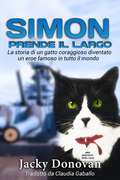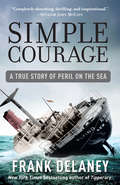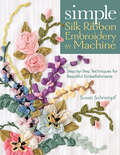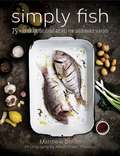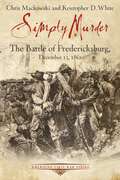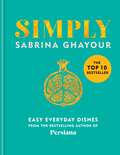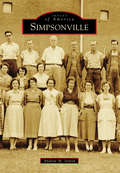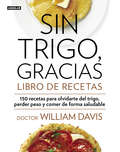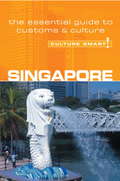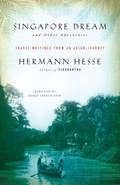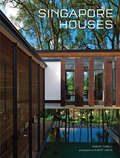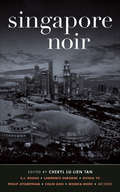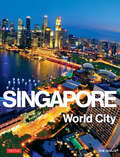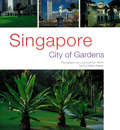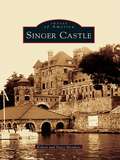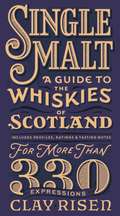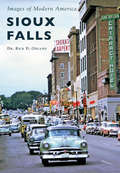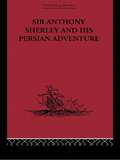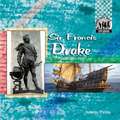- Table View
- List View
Simon prende il largo. La storia di un gatto coraggioso diventato un eroe famoso in tutto il mondo.
by Jacky Donovan Claudia GaballoQuando Simon, un giovane gatto randagio, viene introdotto di nascosto a bordo della nave militare HMS Amethyst, la sua semplice vita tra le strade di Hong Kong si trasforma in un avventura degna di un eroe. Con il merito di aver portato gioia e affetto a bordo della nave, Simon è lunico gatto nella storia ad essere stato investito della PDSA Dickin Medal, il più alto riconoscimento al coraggio per animali in tempo di guerra. Ispirata ai fatti realmente accaduti dell'"Incidente del Fiume Azzurro", la bizzarra ma emozionante storia del Marinaio Scelto Simon commuoverà e divertirà chiunque la legga.
Simple Courage: A True Story of Peril on the Sea
by Frank Delaney“HEAVEN HELP THE SAILOR ON A NIGHT LIKE THIS.”–old folk prayerIn late December 1951, laden with passengers and nearly forty metric tons of cargo, the freighter S.S. Flying Enterprise steamed westward from Europe toward America. A few days into the voyage, she hit the eye of a ferocious storm. Force 12 winds tossed men about like playthings and turned drops of freezing Atlantic foam into icy missiles. When, in the space of twenty-eight hours, the ship was slammed by two rogue waves–solid walls of water more than sixty feet high–the impacts cracked the decks and hull almost down to the waterline, threw the vessel over on her side, and thrust all on board into terror.Flying Enterprise’s captain, Kurt Carlsen, a seaman of rare ability and valor, mustered all hands to patch the cracks and then try to right the ship. When these efforts came to naught, he helped transfer, across waves forty feet high, the passengers and the entire crew to lifeboats sent from nearby ships. Then, for reasons both professional and intensely personal, and to the amazement of the world, Carlsen defied all requests and entreaties to abandon ship. Instead, for the next two weeks, he fought to bring Flying Enterprise and her cargo to port. His heroic endeavor became the world’s biggest news.In a narrative as dramatic as the ocean’s fury, acclaimed bestselling author Frank Delaney tells, for the first time, the full story of this unmatched bravery and endurance at sea. We meet the devoted family whose well-being and safety impelled Carlsen to stay with his ship. And we read of Flying Enterprise’s buccaneering owner, the fearless and unorthodox Hans Isbrandtsen, who played a crucial role in Kurt Carlsen’s fate.Drawing on historical documents and contemporary accounts and on exclusive interviews with Carlsen’s family, Delaney opens a window into the world of the merchant marine. With deep affection–and respect–for the weather and all that goes with it, he places us in the heart of the storm, a “biblical tempest” of unimaginable power. He illuminates the bravery and ingenuity of Carlsen and the extraordinary courage that the thirty-seven-year-old captain inspired in his stalwart crew. This is a gripping, absorbing narrative that highlights one man’s outstanding fortitude and heroic sense of duty. “One of the great sea stories of the twentieth century… [a] surefire nautical crowd-pleaser.”--Booklist é (starred review)“Frank Delaney has written a completely absorbing, thrilling and inspirational account of a disaster at sea that occasioned heroism of the first order. In the hands of a gifted storyteller, the ‘simple courage’ of the ship’s captain and the young radio man who risked their lives to bring a mortally wounded ship to port reveals the essence and power of all true courage–a stubborn devotion to the things we love.”–Senator John McCainFrom the Hardcover edition.
Simple Silk Ribbon Embroidery by Machine: Step-by-Step Techniques for Beautiful Embellishments
by Susan SchrempfUse Any Sewing Machine to Create Embroidered Embellishments. Create intricate silk ribbon embroidery that looks hand-stitched-without the slow hand work. Easy techniques really work with any sewing machine. Classroom-tested lessons specifically designed for beginners include step-by-step how-to photos and ribbon recommendations. Inspiring gallery shows the stitches combined in stunning finished pieces. Do you love the look of silk ribbon embroidery, but not the tedious handwork? Now you can create beautiful embroidery entirely by machine. Susan Schrempf shows you how to create stems, leaves, flowers, roses and rosebuds, loops, French knots, and ruching. Her student-tested techniques make it all so easy!
Simple Thai Food: Classic Recipes from the Thai Home Kitchen
by Leela PunyaratabandhuThai takeout meets authentic, regional flavors in this collection of 100 recipes for easy, economical, and accessible Thai classics--from the rising star behind the blog She Simmers.Who can say no to a delicious plate of Pad Thai with Shrimp; a fresh, tangy Green Papaya Salad; golden Fried Spring Rolls; or a rich, savory Pork Toast with Cucumber Relish? Thai food is not only one of the most vibrant, wonderfully varied cuisines in the world, it also happens to be one of the tastiest, and a favorite among American eaters. The good news is, with the right ingredients and a few basic tools and techniques, authentic Thai food is easily within reach of home cooks. Take it from Leela Punyaratabandhu, a Bangkok native and author of the popular Thai cooking blog She Simmers. In her much-anticipated debut cookbook, Leela shares her favorite recipes for classic Thai fare, including beloved family recipes, popular street food specialties, and iconic dishes from Thai restaurant menus around the world. All of Leela's recipes have been tested and tweaked to ensure that even the busiest cook can prepare them at home. With chapters on key ingredients and tools, base recipes, one-plate meals, classic rice accompaniments, and even Thai sweets, Simple Thai Food is a complete primer for anyone who wants to give Thai cooking a try. By the end of the book, you'll be whipping up tom yam soup and duck red curry that will put your local takeout joint to shame. But perhaps more importantly, you'll discover an exciting new world of Thai flavors and dishes--including Stir-Fried Chicken with Chile Jam, Leaf-Wrapped Salad Bites, and Crispy Wings with Three-Flavored Sauce--that will open your eyes to all the wonderful possibilities that real Thai cooking has to offer.
Simply Fish: 75 Modern and Delicious Recipes for Sustainable Seafood
by Matthew DolanThe frequency of eating fish and seafood has grown worldwide due to the rising interest in healthy living and the desire to add more variety to our diets. Simply Fish explores a wide range of recipes, techniques, and secrets to delivering a restaurant-quality experience in your own home, simply through cooking fish!Chef Matthew Dolan offers his own collection of stories and delicious fish and seafood recipes for a great variety of appetizers, main courses, sauces, side dishes, and desserts-even adding a scattering of wine pairing suggestions along the way. In Simply Fish, you will learn how to cook healthy and delicious fish for every season, from casual and quick get-togethers to the adventurous larger gatherings.Recipes in this helpful guide include:Almond Milk Poached Local CodBarbecued OystersSeared Bay Scallop Fish TacosBeer Steamed MusselsAnd more!
Simply Murder: The Battle of Fredericksburg, December 13, 1862 (Emerging Civil War Series)
by Chris Mackowski Kristopher D. WhiteThis Civil War history and guide offers a vivid chronicle of this dramatic yet misunderstood battle, plus invaluable information for battlefield visitors.The battle of Fredericksburg is usually remembered as the most lopsided Union defeat of the Civil War. It is sometimes called “Burnside’s folly,” after Union commander Maj. Gen. Ambrose Burnside who led the Army of the Potomac to ruin along the banks of the Rappahannock River. Confederates, fortified behind a stone wall along a sunken road, poured a hail of lead into them as they charged. One eyewitness summed it up saying, “it is only murder now.”But the battle remains one of the most misunderstood and misremembered engagements of the war. Burnside started with a well-conceived plan and had every reason to expect victory. How did it go so terribly wrong?Authors Chris Mackowski and Kristopher D. White have worked for years along Fredericksburg’s Sunken Road and Stone Wall, and they’ve escorted thousands of visitors across the battlefield. Simply Murder not only recounts Fredericksburg’s tragic story of slaughter, but includes vital information about the battlefield itself and the insights they’ve learned from years of walking the ground.
Simply: Easy everyday dishes
by Sabrina Ghayour'I have been looking forward to Sabrina Ghayour's new book, Simply, ever since I knew she was writing it... Every page is an invitation to cook.' - Nigella Lawson'Packed with the Iranian-born cook's trademark Persian flavours' - The Herald'The food has immediate "eat me" appeal' - Diana Henry, Sunday Telegraph's 20 Best Cookbooks To Buy This AutumnEasy. Everyday. Simple.Sabrina Ghayour's new collection of unmissable dishes in her signature style, influenced by her love of fabulous flavours, is full of delicious food that can be enjoyed with a minimum of fuss. With sections ranging from Effortless Eating to Traditions With a Twist, Simply provides over 100 bold and exciting recipes that can be enjoyed every day of the week.CONTENTS Chapter one: Effortless Eating Including Spiced carrot & tamarind soup; Date & ginger chicken wings; Baked sweet potato & za'atar chips; Spring onion saladChapter two: Traditions with a Twist Including Green hummus; Kabab koobideh; Persian tahchin; Tahdig e macaroni; Mamen Maleh's borscht; Adas polowChapter three: The Melting Pot Including Steak tartines with tarragon & paprika butter; Chilled pistachio & cucumber soup; Ghayour house chicken kariChapter four: Something Special Including Spiced pork wraps with green apple salsa; Firecracker prawns; Green & black-eyed bean baklava; Mushroom dumplingsChapter five: Cakes, Bakes & Sweet Treats Including Stuffed dates with torched goats' cheese; Lime & black pepper frozen yogurt; Tahini, almond & orange brownies
Simply: Easy everyday dishes
by Sabrina Ghayour'I have been looking forward to Sabrina Ghayour's new book, Simply, ever since I knew she was writing it... Every page is an invitation to cook.' - Nigella Lawson'Packed with the Iranian-born cook's trademark Persian flavours' - The Herald'The food has immediate "eat me" appeal' - Diana Henry, Sunday Telegraph's 20 Best Cookbooks To Buy This AutumnEasy. Everyday. Simple.Sabrina Ghayour's new collection of unmissable dishes in her signature style, influenced by her love of fabulous flavours, is full of delicious food that can be enjoyed with a minimum of fuss. With sections ranging from Effortless Eating to Traditions With a Twist, Simply provides over 100 bold and exciting recipes that can be enjoyed every day of the week.CONTENTS Chapter one: Effortless Eating Including Spiced carrot & tamarind soup; Date & ginger chicken wings; Baked sweet potato & za'atar chips; Spring onion saladChapter two: Traditions with a Twist Including Green hummus; Kabab koobideh; Persian tahchin; Tahdig e macaroni; Mamen Maleh's borscht; Adas polowChapter three: The Melting Pot Including Steak tartines with tarragon & paprika butter; Chilled pistachio & cucumber soup; Ghayour house chicken kariChapter four: Something Special Including Spiced pork wraps with green apple salsa; Firecracker prawns; Green & black-eyed bean baklava; Mushroom dumplingsChapter five: Cakes, Bakes & Sweet Treats Including Stuffed dates with torched goats' cheese; Lime & black pepper frozen yogurt; Tahini, almond & orange brownies
Simpsonville (Images of America)
by Andrew M. StatonSimpsonville was little more than a stop on the road between Greenville and Laurens, South Carolina, when a man named Peter Simpson moved to the area in the 1840s. Simpson became the postmaster and blacksmith for the area, then known as "Plain" or "Dry Ridge," and streets and churches began to spring up, creating a town. By the time of its incorporation in 1901, Simpsonville was thriving as a small railroad town, with a textile mill drawing more to the area in 1908. Under the leadership of two particularly influential and long-standing mayors, Dr. L.L. Richardson and Ralph Hendricks, Simpsonville grew throughout the 20th century to become the hub of commerce and development that it is today.
Sin trigo, gracias. Libro de recetas: 150 recetas para olvidarse del trigo, perder peso y ganar en salud (Guias Visuales Ser.)
by William DavisDisfruta de la revolución de la cocina sin trigo Siguiendo la estela de Sin trigo, gracias, el libro en el que el prestigioso cardiólogo William Davis explica con datos científicos y estudios recientes las graves consecuencias de tomar trigo en nuestra dieta hoy en día -al margen de padecer o no alergias o intolerancias-, llega Sin trigo, Gracias. Libro de recetas, una puesta en práctica de la teoría del doctor. En este libro encontrarás 150 sabrosas recetas para todas las ocasiones especialmente pensadas para cuidar tu peso y mejorar tu salud dejando de lado el trigo en tus comidas. Entre estas páginas encontrarás aperitivos, entrantes y platos principales, así como mucha información útil sobre cómo llevar a cabo una dieta sana sin trigo. Comer sin trigo te ayuda, entre otras cosas, a: * Perder peso * Mejorar los síntomas de la diabetes tipo 2 * Mejorar el colesterol y LDL * Preservar la densidad ósea y evitar la osteoporosis * Mejorar enfermedades de la piel como psoriasis úlceras o alopecia * Aliviar los síntomas de la artritis reumatoide
Singapore - Culture Smart!
by Angela MilliganCulture Smart! provides essential information on attitudes, beliefs and behavior in different countries, ensuring that you arrive at your destination aware of basic manners, common courtesies, and sensitive issues. These concise guides tell you what to expect, how to behave, and how to establish a rapport with your hosts. This inside knowledge will enable you to steer clear of embarrassing gaffes and mistakes, feel confident in unfamiliar situations, and develop trust, friendships, and successful business relationships.Culture Smart! offers illuminating insights into the culture and society of a particular country. It will help you to turn your visit-whether on business or for pleasure-into a memorable and enriching experience. Contents include* customs, values, and traditions* historical, religious, and political background* life at home* leisure, social, and cultural life* eating and drinking* dos, don'ts, and taboos* business practices* communication, spoken and unspoken"Culture Smart has come to the rescue of hapless travellers." Sunday Times Travel"... the perfect introduction to the weird, wonderful and downright odd quirks and customs of various countries." Global Travel"...full of fascinating-as well as common-sense-tips to help you avoid embarrassing faux pas." Observer"...as useful as they are entertaining." Easyjet Magazine"...offer glimpses into the psyche of a faraway world." New York Times
Singapore Dream and Other Adventures: Travel Writings from an Asian Journey
by Hermann Hesse Sherab Chodzin KohnHermann Hesse's voyage to the East Indies, recorded in journal entries and other writings translated into English for the first time, describes the experiences that influenced his greatest works. “I knew but few of the trees and animals that I saw around me by name, I was unable to read the Chinese inscriptions, and could exchange only a few words with the children, but nowhere in foreign lands have I felt so little like a foreigner and so completely enfolded by the self-existing naturalness of life’s clear river as I did here.” In 1911, Hermann Hesse sailed through southeastern Asian waters on a trip that would define much of his later writing. Hesse brings his unique eye to scenes such as adventures in a rickshaw, watching foreign theater performances, exploring strange floating cities on stilts, and luxuriating in the simple beauty of the lush natural landscape. Even in the doldrums of travel, he records his experience with faithful humor, wit, and sharp observation, offering a broad vision of travel in the early 1900s. With a glimpse into the workings of his mind through the pages of his journals, poems, and a short story—all translated into English for the first time—these writings describe the real-life experiences that inspired Hesse to pen his most famous works.
Singapore Houses
by Robert Powell Albert Lim KsDemonstrating a remarkable surge of design exploration in the city-state, Singapore Houses charts the architects of Singapore whom are producing work with a level of refinement and sophistication that is comparable with the best in the world. The houses include recent designs by doyens of the profession such as Sonny Chan Sau Yan, Kerry Hill and Ernesto Bedmar in addition to the firmly established "next" generation including Mok Wei Wei, Chan Soo Khian, Siew Man Kok and Richard Hassell.
Singapore Noir (Akashic Noir)
by Cheryl Lu-Lien Tan"Singapore, with its great wealth and great poverty existing amid ethnic, linguistic, and cultural tensions, offers fertile ground for bleak fiction, as shown by the 14 tales in this solid Akashic noir anthology...Tan has assembled a strong lineup of Singapore natives and knowledgeable visitors for this volume exploring the dark side of a fascinating country."--Publishers Weekly"Singapore Noir is another fine addition to the Akashic's Noir series. Under Cheryl Lu-Lien Tan's tutelage, the stories puncture the stereotypes associated with Singapore and push the genre in new directions."--Chicago Center for Literature and PhotographyIncluded in Recent Books of Note, Toronto StarA Book of the Week pick at Susan Blumber-Kason's blog"Singapore Noir is for the Noir fiction lover."--A Bibliophile's Reverie"If you like noir and would like to catch up on the seedy underbelly of one of the Four Asian Tigers (Dragons), give this anthology a read."--Write LiesLaunched with the summer '04 award-winning best seller Brooklyn Noir, Akashic Books continues its groundbreaking series of original noir anthologies. Each book is comprised of all-new stories, each one set in a distinct neighborhood or location within the city of the book.Brand-new stories by: Colin Goh, Simon Tay/Donald Tee Quee Ho, Philip Jeyaretnam, Colin Cheong, Cheryl Lu-Lien Tan, Monica Bhide, S.J. Rozan, Lawrence Osborne, Suchen Christine Lim, Ovidia Yu, Damon Chua, Johann S. Lee, Dave Chua, and Nury Vittachi.From the introduction by Cheryl Lu-Lien Tan:"Say Singapore to anyone and you'll likely hear one of a few words: Caning. Fines. Chewing gum.For much of the West, the narrative of Singapore--a modern Southeast Asian city-state perched on an island on the tip of the Malay Peninsula--has been marked largely by its government's strict laws and unwavering enforcement of them...As much as I understand these outside viewpoints, I have always lamented that the quirky and dark complexities of my native country's culture rarely seem to make it past its borders...Beneath its sparkling veneer is a country teeming with shadows...And its stories remain. The rich stories that attracted literary lions W. Somerset Maugham and Rudyard Kipling to hold court at the Raffles Hotel (where the Singapore Sling was created) are still sprinkled throughout its neighborhoods. And in the following pages, you'll get the chance to discover some of them...You'll find stories from some of the best contemporary writers in Singapore--three of them winners of the Singapore Literature Prize, essentially the country's Pulitzer: Simon Tay, writing as Donald Tee Quee Ho, tells the story of a hard-boiled detective who inadvertently wends his way into the underbelly of organized crime, Colin Cheong shows us a surprising side to the country's ubiquitous cheerful 'taxi uncle,' while Suchen Christine Lim spins a wistful tale of a Chinese temple medium whose past resurges to haunt her...As for mine, I chose a setting close to my heart--the kelongs, or old fisheries on stilts, that once dotted the waters of Singapore but are gradually disappearing. I have a deep sense of romance about these kelongs, along with the many other settings, characters, nuances, and quirks that you'll see in these stories. They're intense, inky, nebulous. There is evil, sadness, a foreboding. And liars, cheaters, the valiant abound.This is a Singapore rarely explored in Western literature--until now. No Disneyland here; but there is a death penalty."
Singapore World City
by Kim InglisIn just a few short decades, Singapore has transformed itself from a tiny island off the coast of mainland Asia into a global superpower in banking, IT, education, biotech, transportation and many other fields. The fascinating story of how this tiny city-state which has no hinterland, no natural resources, and a relatively small population has achieved success is told in this book. Singapore's history as a British colonial port, its dynamic multi-ethnic population, and its innovative governmental and social structures, are a part of the story. But there are others as well. How Singapore became a regional hub for finance, shipping and air travel, and now also for the arts, sport and leisure-are all showcased in dynamic detail, with over 300 full-color photographs to illustrate graphically how this small island functions like a well-tuned racing machine. From the world's only night-time Formula One race to its thriving calendar of international and local events, and its culture of non-stop eating, drinking and clubbing, Singapore has finally stepped out of the shadows and onto the world stage. Famed for its innovative business prowess, what is less known is that the island has more parks, gardens and recreational facilities than any other city of comparable size. Author Kim Inglis, a journalist and long-time local resident, leads the reader on a series of explorations through Singapore's most notable districts and neighborhoods, explaining the growth and importance, and showcasing what they have to offer the visitor. Included are many lesser-known corners of the island which very few visitors ever get to see!
Singapore World City
by Kim InglisIn just a few short decades, Singapore has transformed itself from a tiny island off the coast of mainland Asia into a global superpower in banking, IT, education, biotech, transportation and many other fields. The fascinating story of how this tiny city-state which has no hinterland, no natural resources, and a relatively small population has achieved success is told in this book. Singapore's history as a British colonial port, its dynamic multi-ethnic population, and its innovative governmental and social structures, are a part of the story. But there are others as well. How Singapore became a regional hub for finance, shipping and air travel, and now also for the arts, sport and leisure-are all showcased in dynamic detail, with over 300 full-color photographs to illustrate graphically how this small island functions like a well-tuned racing machine. From the world's only night-time Formula One race to its thriving calendar of international and local events, and its culture of non-stop eating, drinking and clubbing, Singapore has finally stepped out of the shadows and onto the world stage. Famed for its innovative business prowess, what is less known is that the island has more parks, gardens and recreational facilities.
Singapore: City of Gardens
by Luca Invernizzi Tettoni William WarrenMost visitors to Singapore marvel at the greenness of it all. Wide Boulevards shaded by venerable Rain Trees, interconnecting parks displaying a huge variety of tropical plants, roadside plantings in every shade of green, red and yellow, and great expanses of junglescape alongside the office skyscrapers and apartment blocks. It is truly a garden city, in all senses of the word. In this volume, we showcase many of the Lion City's green spaces, be they the Botanical Gardens and national parks, or plantings of bougainvillea tumbling down the crash-barriers on the super-highways. Orchid Road, the world-renowned Zoological Gardens, the ground-breaking Mandai Orchid Gardens, and many more, are portrayed, along with other lesser-known parks and private and hotel gardens. Sumptuous full -color photographs by Luca Invernizzi Tettoni and texts by botanical expert William Warren literally take one down the garden path on a discovery tour of Singapore's cityscapes, landscapes, hardscapes and few remaing "wild-scapes".
Singapore: World City
by Kim InglisIn just a few short decades, Singapore has transformed itself from a tiny island off the coast of mainland Asia into a global superpower in banking, IT, education, biotech, transportation and many other fields. The fascinating story of how this tiny city-state which has no hinterland, no natural resources, and a relatively small population has achieved success is told in this book.Singapore's history as a British colonial port, its dynamic multi-ethnic population, and its innovative governmental and social structures, are a part of the story. But there are others as well. How Singapore became a regional hub for finance, shipping and air travel, and now also for the arts, sport and leisure-are all showcased in dynamic detail, with over 300 full-color photographs to illustrate graphically how this small island functions like a well-tuned racing machine.From the world's only night-time Formula One race to its thriving calendar of international and local events, and its culture of non-stop eating, drinking and clubbing, Singapore has finally stepped out of the shadows and onto the world stage. Famed for its innovative business prowess, what is less known is that the island has more parks, gardens and recreational facilities.
Singapore: World City
by Kim InglisIn just a few short decades, Singapore has transformed itself from a tiny island off the coast of mainland Asia into a global superpower in banking, IT, education, biotech, transportation and many other fields. The fascinating story of how this tiny city-state which has no hinterland, no natural resources, and a relatively small population has achieved success is told in this book.Singapore's history as a British colonial port, its dynamic multi-ethnic population, and its innovative governmental and social structures, are a part of the story. But there are others as well. How Singapore became a regional hub for finance, shipping and air travel, and now also for the arts, sport and leisure-are all showcased in dynamic detail, with over 300 full-color photographs to illustrate graphically how this small island functions like a well-tuned racing machine.From the world's only night-time Formula One race to its thriving calendar of international and local events, and its culture of non-stop eating, drinking and clubbing, Singapore has finally stepped out of the shadows and onto the world stage. Famed for its innovative business prowess, what is less known is that the island has more parks, gardens and recreational facilities.
Singapore: World City
by Kim InglisIn just a few short decades, Singapore has transformed itself from a tiny island off the coast of mainland Asia into a global superpower in banking, IT, education, biotech, transportation and many other fields. The fascinating story of how this tiny city-state which has no hinterland, no natural resources, and a relatively small population has achieved success is told in this book.Singapore's history as a British colonial port, its dynamic multi-ethnic population, and its innovative governmental and social structures, are a part of the story. But there are others as well. How Singapore became a regional hub for finance, shipping and air travel, and now also for the arts, sport and leisure-are all showcased in dynamic detail, with over 300 full-color photographs to illustrate graphically how this small island functions like a well-tuned racing machine.From the world's only night-time Formula One race to its thriving calendar of international and local events, and its culture of non-stop eating, drinking and clubbing, Singapore has finally stepped out of the shadows and onto the world stage. Famed for its innovative business prowess, what is less known is that the island has more parks, gardens and recreational facilities.
Singer Castle
by Robert Mondore Patty MondoreIn 1905, the New York Times called it "the Castle of Mysteries," and rightly so. Located on Dark Island, Singer Castle was modeled after the castle described in Sir Walter Scott's Woodstock, complete with dungeons, turrets, labyrinths, and even secret passageways. World-famous architect Ernest Flagg designed it for Singer Sewing Machine Company president Frederick Bourne. Singer Castle provides an unforgettable tour and fascinating history, revealing why this place is truly a castle of mysteries.
Single Malt Whisky: A Guide to the Whiskies of Scotland: Includes Profiles, Ratings, and Tasting Notes for More Than 330 Expressions
by Clay RisenA follow-up to his bestselling American Whiskey, Bourbon & Rye: A Guide to the Nation's Favorite Spirit, Clay Risen's Single Malt is an introduction to the long history, fascinating science, and incredible diversity of malted whisky, as well as a practical drinker's guide to buying and enjoying hundreds of the greatest examples of the distiller's tradition. With maps of essential whisky regions of Scotland, profiles of each of the makers, and photographs of the bottles and tasting notes for each of the most widely available expressions--compiled from tasting sessions conducted by a panel of leading whisky experts--readers will discover a rich vein of knowledge about one of the world's most storied beverages.Selected from more than one hundred active distilleries in Scotland, the 330 expressions featured in this book provide a curated yet comprehensive primer of the single-malt whiskies any growing aficionado should be familiar with. Additional features include a directory of distilleries, Risen's top whisky picks in various categories, and a full index of the expressions featured in the book.
Sioux Falls (Images of Modern America)
by Dr Rick OdlandThe 1950s and 1960s were a time of historic growth, when over 20,000 new residents chose to make Sioux Falls their home. In 1981, Citibank came to Sioux Falls, bringing many more people to the city. Since the start of the 21st century, health care has been the job sector employing the most people in Sioux Falls, creating jobs and bringing many new medical specialties to the area. New entertainment, restaurants, parks, and shopping have improved the quality of life for locals. As the population has increased, Sioux Falls has proven it can keep up with demand.
Sir Anthony Sherley and his Persian Adventure
by Anthony SherleyAs well as including Sherley's own account of his journey into Persia in 1600, this valuable edition includes the main works dealing with Anthony Sherley and his life. Original inaccessible texts are reprinted in full and the critical bibliographical introduction provides excellent guidance for the understanding of the various sources (and their merits and limitations), and the context in which Sherley's own account was composed.When first published in 1933, Sherley's narrative (1613) had never before been reprinted.
Sir Francis Drake
by Kristin PetrieA biography of the English seaman and explorer who was knighted by Queen Elizabeth I.
